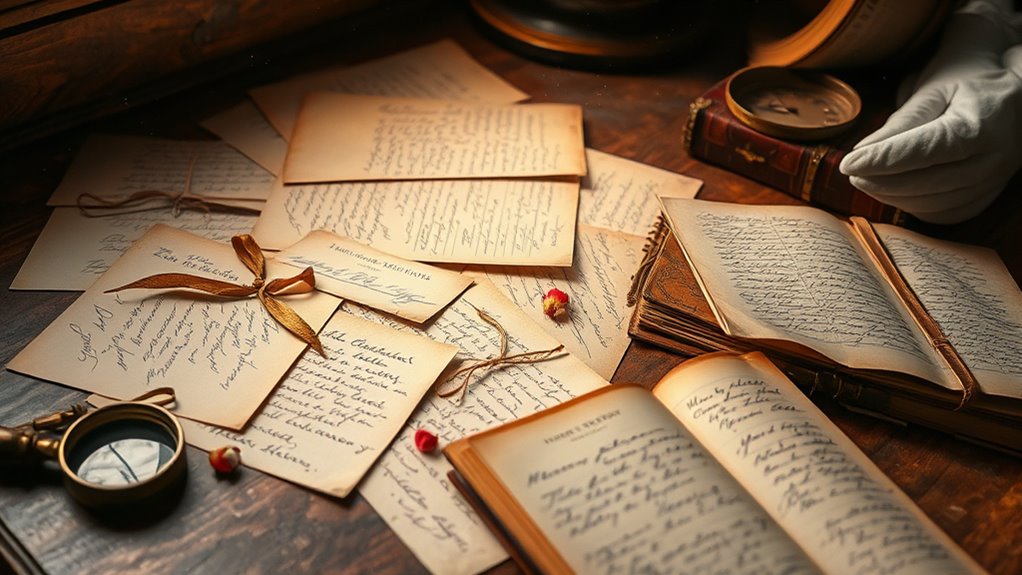To preserve family letters and diaries, store them in acid-free boxes and folders in a cool, dark, and dry environment. Handle with gloves or clean hands to prevent damage, and regularly check for signs of deterioration. Consider creating high-resolution digital copies for easy sharing and backup, keeping digital files organized and protected. Combining physical storage with digital preservation helps guarantee your family stories endure for future generations—if you want to explore more, keep going.
Key Takeaways
- Store letters and diaries in acid-free, lignin-free containers in a cool, dry, dark environment to prevent deterioration.
- Handle with clean hands or gloves to avoid oils and dirt damaging fragile paper.
- Regularly inspect items for signs of deterioration and repair minor damages promptly.
- Digitize documents using high-resolution scanning and organize files with descriptive metadata for easy access.
- Create multiple digital backups stored in different locations to ensure preservation and easy sharing.

Preserving family letters and diaries is essential for maintaining a tangible connection to your ancestors’ lives and stories. These personal artifacts hold invaluable insights into their daily experiences, emotions, and the historical context in which they lived. To ensure these treasures endure, you need to consider proper archival storage. This involves storing your documents in acid-free, lignin-free boxes or folders that prevent deterioration over time. Keep them in a cool, dry, and dark environment, away from fluctuations in temperature and humidity, which can accelerate decay. Avoid exposure to direct sunlight, as it can cause fading and weaken paper fibers. Handling these items with clean hands or gloves helps prevent oils and dirt from causing damage. Regularly inspecting them for signs of deterioration allows you to catch issues early and take corrective action, such as repairing tears or consolidating fragile areas with appropriate materials.
In addition to physical preservation, digital conversion offers a practical way to safeguard these documents against loss or damage. Scanning your family letters and diaries creates a high-resolution digital copy that can be easily stored, shared, and backed up across multiple devices or cloud services. This process not only preserves the content but also makes it more accessible for research or family storytelling. When digitizing, use a flatbed scanner with a gentle, even light to avoid damaging the originals. Save files in widely compatible formats like PDF or TIFF for long-term usability, and organize them clearly with descriptive filenames and metadata. Digital copies serve as a protective measure—if physical items are accidentally damaged, lost, or deteriorate beyond repair, you’ll still have a faithful record of their content.
Moreover, digitization allows you to share these treasured documents with other family members or historians without risking the originals. It also simplifies creating backups, ensuring that multiple copies are stored securely in different locations. Remember, digital conversion isn’t a one-time task; maintaining your digital archives with regular backups ensures ongoing preservation. Combining proper archival storage methods for the originals with diligent digital conversion provides a thorough approach to safeguarding your family’s history. This dual strategy not only protects your ancestral stories from physical and digital threats but also ensures they remain accessible for future generations to cherish and learn from. By taking these steps, you honor your ancestors’ memories while creating a lasting legacy that can be passed down with confidence and care. Additionally, understanding the importance of copyright and privacy considerations helps you respect your family’s rights and confidentiality when sharing or digitizing sensitive materials.
Frequently Asked Questions
How Can I Digitize Old Handwritten Family Documents?
You can digitize old handwritten family documents by using a high-quality scanner for digital scanning. Guarantee you handle fragile pages carefully and scan at a high resolution for clarity. Save the files in common formats like PDF or JPEG. Then, organize and store these digital copies in archival storage solutions, such as external drives or cloud services, to keep your family history safe and accessible for years to come.
What Are the Best Storage Materials for Preserving Fragile Papers?
When it comes to storing fragile papers, you should use acid-free enclosures to prevent deterioration from acidity. Polyethylene sleeves are also ideal, offering protection while allowing you to handle documents without direct contact. These materials help maintain the paper’s integrity over time. Always choose archival-quality storage options to guarantee your family documents stay safe and preserved for future generations.
How Often Should I Inspect Preserved Family Documents?
You might think inspecting preserved family documents isn’t vital, but regular maintenance actually helps catch issues early. Experts recommend an archival review every 1-2 years to guarantee they stay in good shape. During these inspections, check for signs of deterioration like discoloration or tears. Consistent frequency maintenance prevents irreversible damage, making sure your family history remains intact for generations to come. So, don’t skip these essential, routine reviews.
Are There Professional Services for Restoring Damaged Letters?
You might wonder if professional help is available for restoring damaged letters. Yes, archival restoration is a specialized field, and conservation specialists can carefully repair and stabilize delicate documents. They use advanced techniques to prevent further deterioration and preserve your family’s history. Contacting these experts guarantees your letters receive expert care, protecting their integrity for future generations. Don’t attempt DIY repairs, as improper methods can cause more harm than good.
What Legal Considerations Exist When Sharing Family Documents Online?
Think of sharing family documents online like opening a treasure chest—exciting but risky. You need to contemplate copyright laws, which protect original content, and privacy concerns, especially if sensitive info involves living relatives. I once saw a family share letters, only to face legal trouble because they didn’t respect these rules. Always verify copyright status and get family consent to avoid legal issues and respect privacy.
Conclusion
By safeguarding your family letters and diaries, you’re weaving your own chapter into history, much like the archivists of old who preserved stories for generations to come. Remember, each document is a thread in the fabric of your family’s story, waiting to be rediscovered and cherished. As with the timeless tales of ancestors, your efforts guarantee that future generations will read your story and find their own sense of belonging within it.






